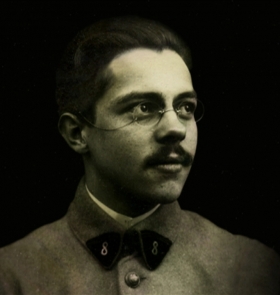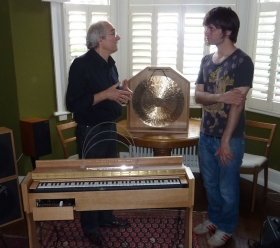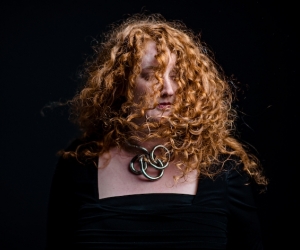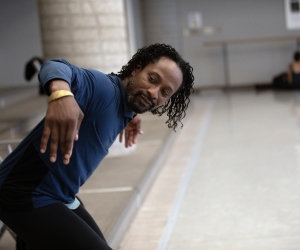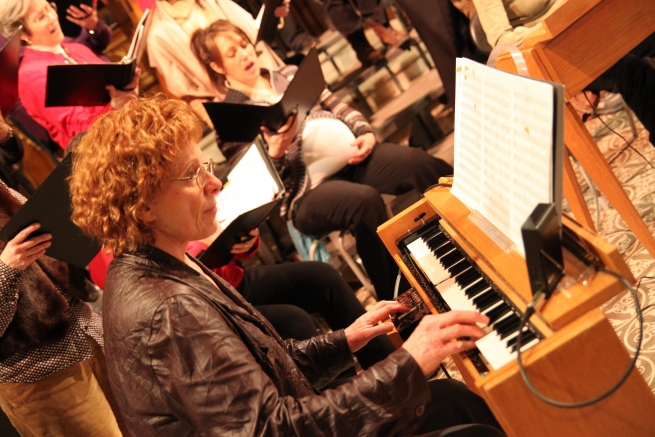
No one knows exactly how many functioning ondes Martenot are in use around the world today, but an informed, conservative estimate puts their number at sixty. In the course of half a century, Maurice Martenot, the creator of this most sensitive electronic musical instrument, was able to handcraft around 270 of them. More interested in perfecting the seven successive models of his invention than in commercializing it, Martenot never ceased experimenting and responding to the special requests of performers and composers. When the inventor died in a Moped accident in 1980, production of the instrument declined, finally ending when his assistant Marcel Manière retired in 1988. With the instrument’s future uncertain, the French government offered in the early 1990s to support renewed building of the Martenot, but on the condition that it be made digital. About a dozen new instruments were made, but the venture ended in bitter disappointment for the Martenot community—and for Martenot’s two older sons, who led the initiative—because the timbres could not compare with those of the last transistor model.
Over the years, the world’s approximately forty ondists (that’s what specialist players of the instrument are called), who are mostly located in France, Quebec and Japan, have been plagued by the constant need to repair and restore aging instruments. And it has been almost impossible for anyone outside of this circle to buy one secondhand. The seven active Canadian ondists are currently welcoming an upgrade of their instruments, which is being done by Jean Landry, their repairman for twenty-five years, who himself is currently looking for a successor to keep servicing the instruments. The Martenot is still taught in conservatories in France, Switzerland, and Japan; in Canada, the Conservatoire de Montréal provided teaching until the late 1990s; but the scarcity of instruments had made practising complicated to arrange. Preservation and access have long been in conflict. The Martenot family has been reluctant to share many of the trade secrets, especially the recipe for the famous electric powder (a mixture activated by a charge running throught it) under the expression key. The name Ondes Martenot is trademarked, so Martenot-family approval is required before any new model can be called a Martenot. As well, the ondists’ attachment to the original (although, it should be noted, no two are exactly the same) has made them virtual “guardians of the temple.” So it’s tricky for instrument builders to explore possible technical modifications—let alone to earn a living making the Martenot.
Deprogramming Obsolescence
You have probably heard its ethereal voice—in Olivier Messiaen’s contemporary symphonies, in the 1960s British TV series Thunderbirds, in film scores by Maurice Jarre, in popular recordings of Édith Piaf or on Radiohead’s 2000 album Kid A. But perhaps you mistook it for something else. The sound of the Martenot is still regularly confused with that of the Theremin. In a reductive, linear, analog-to-digital chronology—and because it uses electricity and has a keyboard—the instrument is often depicted simplistically as an ancestor of the synthesizer. But to approach the Martenot as a rare, vintage (if not obsolete) electronic musical instrument is to miss the central point: its remarkable musical sensibility.
In Maurice Martenot’s vision, sound production through electricity meant there was no material interference from, for instance, strings or hammers, as is typical of traditional instruments. This would spare players the effort of producing acoustic vibrations, allowing them to focus on expressivity, i.e., to intervene live, and with versatility and granularity, on all parameters of musical sound: pitch, intensity, attack, duration, timbre. Arising from Martenot’s dream of unmediated musical thought was this paradoxically strong, almost sensual connection to the instrument. Radiohead’s Jonny Greenwood told me, when I was filming him for my documentary Wavemakers, “While trying to make electronic music I’m trying to keep it organic, something you can touch rather than just keep inside a box.” The multi-instrumentalist, who has significantly contributed to bringing the Martenot to a wider audience, succinctly sums up its appeal: “I’ve got a synthesizer. It’s just switches. You can’t put
your personality into it like you can with a violin or an oboe. The Martenot is the only electronic instrument that can do that.”
To many artists and scientists currently trying to build sensor-based instruments that respond to subtle movements, the Martenot embodies their ideal. Martenot conceived the instrument as an extension of the human nervous system, its sensitive design linking electricity to the human body. His instrument was made to facilitate the expression of “the music that sings in us,” as he wrote in “À propos des Ondes sonores,” a 1929 article that reads today like a manifesto.
Martenot and his invention carry practical and philosophical understandings of the possibilities electricity offers to music, and what it means to make—or even to emit—music, and how musical subjects play. They invite us to displace the common vision of electronic musical instruments as gear, and to consider a history not very well documented, especially in the English-speaking world. Told only in one book (Montreal ondist and writer Jean Laurendeau’s 1990 Maurice Martenot, Luthier de l’électronique), the history of the Martenot has been hard to access and, at times, somewhat “defective”—much as the instrument, unfortunately, happens to be.
Les Impondérables
Described in many encyclopedias as a French engineer, Maurice Martenot (1898–1980) was in fact not a scientist but a musician and a questing educator in search of balance between the artistic impulse and spiritual development. He served as a wireless operator during the First World War, and the sound produced by the frequencies coming out of the triode tubes of his radio had him imagining an instrument using the new materials of his time. Despite its being a pure product of war-gear adaptation, the Martenot’s trajectory is quite remote from the canonized history of electronic music, whose origins trace back to Luigi Russolo’s Art of Noises (1913), and which typically fetishizes technology. It presents an alternative narrative that musician and academic Tara Rodgers recognizes as “an ‘elsewhere’ within electronic music discourses . . . a space for mutual encounters between humans and technologies, between familiarity and otherness, that motivates wonder and a sense of possibility instead of rhetorics of combat and domination” (“Toward a Feminist Historiography of Electronic Music” from The Sound Studies Reader, 2012).
The distinct historical experience of the Martenot—and of Martenot, its humanist pedagogue—constitutes a unique body of reflection on music itself. In addition to his life of incessant research and invention, including collaborations with many great composers of his time, Martenot also created the musical pedagogy group “Research and Development” with his two sisters. He and they ran a music school in Neuilly-sur-Seine, expanding on the avant-garde method, known as the Martenot Method, that his eldest sister Madeleine developed in the 1910s and that is still taught today. It turns out that Maurice Martenot was more interested in discovering the possibilities for universal, collective, physiopsychological, and even biological resonances in our rapport with music. He welcomed the partially uncontrolled and unconscious surges that can imbue a musician’s playing with elusive spontaneity and give way to human imperfections that make it all the more authentic. This was part of his inquiry into music production and sensory experience, an exploration into the quasi-philosophical concept of what he called les impondérables. For him, technological, musical, and organic systems were to be conceived in tune with one another. Martenot objected to the notion of music as an abstraction in relation to the human world, which is a hallmark of modernist, machinist, and academic thinking on electronic music. “The instrument is first and foremost ourselves,” he often pointed out. This was also the premise of his last work, coauthored with Christine Saïto, Se relaxer? Le corps, expression de l’être (1977), a book about the active relaxation technique he developed and experimented with all his life.
Although some consider the Martenot to be the musical invention of the twentieth century, the instrument has yet to be reassessed in the rich and unique context of the Martenots’ philosophical and pedagogical legacy. But with electronic instrument-builders now pursuing the creation of future models of the Martenot, with repertoire expanding into many musical genres, and with researchers aspiring to keep its heritage alive, the Martenot is moving towards a timely rediscovery—and is on the verge of making new waves.
Over the years, many legends have surrounded the art and craft of building the Martenot. In a remarkable turn of events, the risk of mummification or extinction has prompted a proliferation of initiatives to renew production. After acquiring the last digital Martenot, Radiohead’s Jonny Greenwood wanted to share and preserve its legacy without damaging it. In 2000, he commissioned the Cornish company Analogue Systems to develop a Martenot-style controller for his modular analog synthesizers. Conserving the ring on the wire and the expression key, this controller—dubbed the French Connection—offers the expressive potential of the Martenot to electronic music aficionados everywhere.
Under the influence of virtuoso ondist and long-time Conservatoire teacher Jeanne Loriod, the French Ondes Martenot association commissioned Ambro Oliva, a music-loving engineer and industrialist, to pursue production in the late 1990s. In 2001, a prototype of his Ondéa, which replicates the original Martenot, was first used in concert. By 2008, some fifteen sturdy instruments had been delivered, one of them to Kraftwerk leader Ralf Hütter. The eighty-five-year-old Oliva recently passed the torch to electronics specialist Frédéric Roussel.
Jeanloup Dierstein works night and day in his tiny Paris workshop. The former righthard man of Jean Michel Jarre and Vangelis, Dierstein now tweaks for bands such as Daft Punk and Air. He went from repairing Martenot to restoring them, and eventually began collaborating with Jean-Louis Martenot on a new line. The first Ondes Musicales Dierstein was acquired by Greenwood in July 2011, and about twenty of them will have been delivered by the end of 2013—eighty per cent of them outside of France. For the record, the notorious expression key is crafted on Dierstein’s instrument not with a powder pouch but with a sensor and a pad to keep the original tactile sensation. Dierstein also added a control output for analog synthesizers, which expands the variety of timbres.
Ever since Martenot demonstrated his invention in Japan’s Yamaha factory during his early-1930s world tour, the instrument’s future has seemed bright in Japan—from the renowned accomplishments over the past thirty years of virtuoso performer and prolific composer Takashi Harada to the recent efforts of former diamond-hunter Naoyuki Omo, who became smitten with the Martenot sound and is now making new analog instruments in his Tokyo workshop.
A new digital model is currently being completed by Claude Jaccard, a pipe-organ maker, who has teamed up with Christophe Baurand, an engineer and expert in obsolescence management. The Onde Musicale BJ amplifies the signal through tubes, to generate a warmer sound. It will be a more portable, lighter instrument, easier to fix, and aimed more specifically at students, rental clients, and new Martenot enthusiasts.
Last but not least, scientists have now entered the Martenot field. With the assistance of his Lutherie-Acoustique-Musique laboratory team and ondist Nadia Ratsimandresy, Hugues Genevois currently experiments with new speaker types. Paris-based Stéphane Vaiedelich, a member of the international scientific team that discovered the secret of the Stradivarius varnish, has also set his sights on the Martenot: he recently used measurement-based science to “discover” the recipe of what he calls “the wizard’s powder,” the material used under the instrument’s expression key.
A resurgence of Martenot-inspired tinkering projects is definitely underway. A quick Internet search of “DIY Ondes Martenot” yields an array of home projects around the globe that are trying to emulate the instrument’s playing interface and sound. “Petites Ondes” is the world’s first iPad application to reproduce the sound of the Martenot. “You can play it casually during a break for coffee,” reads the description of the Japanese-designed app. Although electronic music devotees may thrill at the verisimilitude of the sampled timbres on this app or on the latest synthesizers, this misses the point and spirit of the instrument: its highly sensitive playing interface.
Ultimately, as Jean-Louis Martenot says, “The ingredients aren’t what matters. It’s how they are used. It’s really about how the musician will bring something out of the instrument!”
Read companion articles "The Ondes Martenot at Play" and "New Wave Encounters" in the print edition of Musicworks #117.
Audio: V’er l’or, Extended (2012). Improvisation by Suzanne Binet-Audet (Martenot) and David Madden (bass) created for the film Wavemakers. Image (top): Composer Marie Bernard of the Ensemble d’Ondes de Montreal. Image (top) by: Caroline Martel. Image (middle): Maurice Martenot served as a wireless opereator during the First World War. (Still from Wavemaker, courtesy of Caroline Martel. Image (bottom): Jeanloup Dierstein (left) and Jonny Greenwood. Image (bottom): Courtesy of Thomas Bloch. Home page slider image: The expression key, with powder pouch, of the ondes Martenot. Slider image by: Caroline Martel.

